In this tutorial, we will be looking at how to perform a basic forehand topspin serve. This serve is used to get the point started successfully, and prevent the receiver from making a strong attack against the serve.
Ready Position
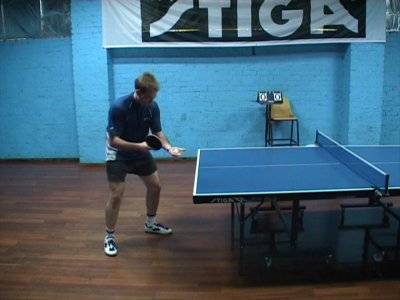
© Greg Letts
Points to look for:
- The feet are placed at roughly a 45 degree angle to the endline of the table, which allows the stroke to be played comfortably.
- The knees are slightly bent, and the legs a little more than shoulder width apart to give better balance and faster recovery after the serve is completed.
- The ball is placed on the palm of the free hand, which is flat and stationary. Also notice that the free hand is behind the endline and above the level of the playing surface.
- The torso is slightly bent forward, to allow better balance.
- The bat is held ready just behind the free hand, with the playing elbow bent at around 90 degrees.
Middle Of Backswing
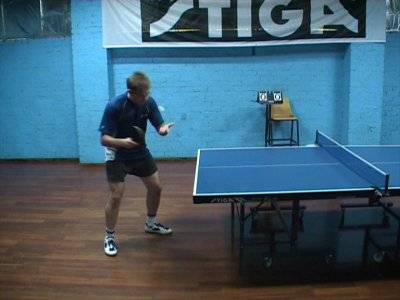
© Greg Letts
The service has begun, with the ball thrown into the air and the bat in the middle of the backswing.
Points to look for:
- The ball has been tossed near vertically upwards, in accordance with the service laws. The actual height of the toss will vary from player to player, but must be more than 16cm.
- The bat has been moved backwards and slightly upwards, via a slight turn of the shoulders and a backwards movement of the racket arm.
- The player is focusing closely on the ball.
End Of Backswing
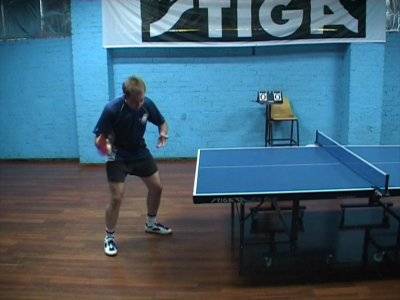
© Greg Letts
The backswing has finished, and the forward swing about to start.
Points to look for:
- The shoulders have continued to turn, and are now approximately at a 45 degree angle to the endline of the table.
- The bat has continued to move backwards and slightly downwards into position.
- The player has continued to focus on the ball.
- The player has a slight forward lean from the waist.
- The bat is in a near vertical position, with the tip pointing towards the camera.
Contact With The Ball
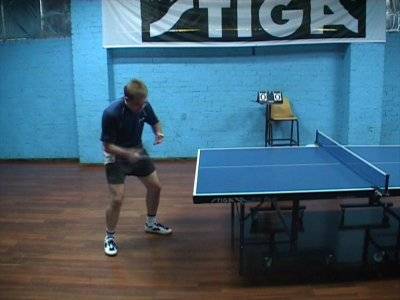
© Greg Letts
The player has made contact with the ball.
Points to look for:
- The player is continuing to watch the ball.
- As can be seen from the slight blurring of the bat, the bat is moving forwards and downwards to hit the ball, but is held with the top edge of the bat slightly forward of the bottom edge.
- The bat is moved upwards and forwards just before contact with the ball, to impart topspin on the ball.
- The shoulders have begun to turn back towards the table, while the playing forearm is also moving towards the table.
- The player has leant a little further forward to allow comfortable contact.
- The free arm has been stationary throughout the service.
First Bounce Of Ball On Table
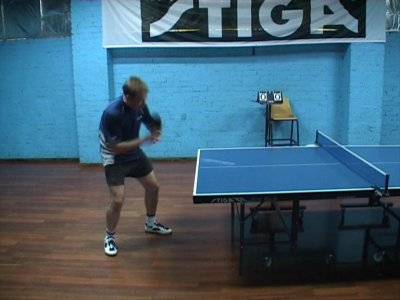
© Greg Letts
The ball has is just about to make its first bounce on the table.
Points to look for:
- The shoulders have continued to turn back towards their original position.
- The bat has continued moving upwards.
- The player is watching the progress of the ball closely.
- The free arm is still stationary.
- The ball is bouncing over a foot inside the endline, since the player wants to the ball to bounce twice on the opponent’s side of the table. It can be difficult to double bounce the serve if a lot of topspin is put on the ball.
Ball Goes Over Net
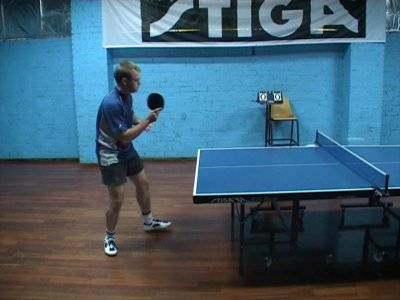
© Greg Letts
The ball is passing over the net.
Points to look for:
- The player is beginning to come out of his crouch, and is returning to his basic ready position.
- The bat has finished much higher than for the forehand backspin and forehand float services.
- The player is continuing to watch the ball, as well as how the opponent is preparing to hit the ball.
- The shoulders have nearly returned to their original positions.
- The ball has passed only a few inches over the net, which helps make the serve harder to attack.
Return To Ready Position
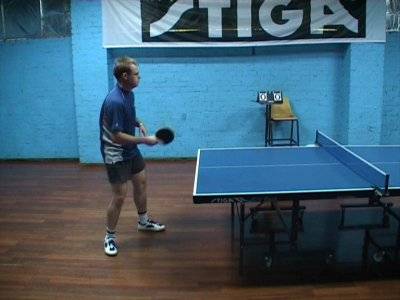
© Greg Letts
The player is returning to his basic ready position.
Points to look for:
- The player has continued to straighten his torso, and his shoulders have now returned to their original position.
- The player has dropped his bat a little to put it back in the ready position for his next shot.
- Ideally, the player would have a little more forward lean and slightly wider feet to allow him to be in optimal position.
- The free arm will be moved forward a little to be in its ready position.
- The knees retain their slight bend, in preparation for the next stroke. In actual fact, a little more bend in the knees than shown in the photograph would be preferable.

